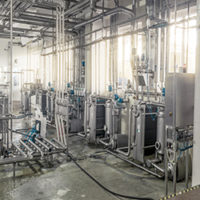Het Kaasmerk is a manufacturer of these edible cheese marks and has
collaborated with Isotron Systems for the traceability and quality
control of cheese.
Het Kaasmerk B.V. of Leiden in the Netherlands is using the DataMan to read the codes marked on individual blocks of cheese. The cheese is marked with a 2D code early in the production process and the code needs to be read at the end of the production process. The only ID reader solution Het Kaasmerk found that was capable of meeting this challenge, despite a tough industrial environment that is very damaging to the code, was the In-Sight Vision System and the DataMan 7500 from Cognex.
Advantages of using 2D codes:
Increased food safety
Prevention of product recall
Saving the customer time and money
Identification codes, such as a 2D code or Datamatrix, are applied to state-of-the-art technology products and food products, and are not only mandatory in Europe, but also are necessary for safeguarding food quality during production. They help minimize food safety risks after the production phase because each end product can be individually traced back to the production lot. Het Kaasmerk is a manufacturer of these edible cheese marks and has collaborated with Isotron Systems for the traceability and quality control of cheese for some time now. Isotron Systems is the distributor of Cognex vision and ID products in the Netherlands.
Complete traceability for each piece of cheese
The ability to identify each individual cheese as a unique item in the production chain is an essential component. The applied code functions as a veritable passport. In the past, these codes consisted of regular text, which had many disadvantages. Isotron Systems and Het Kaasmerk sat down and jointly introduced the edible 2D dot matrix codes to cheese producers. They improved the contrast and cell size of the 2D code on the cheese marks. This unique code can be paired with essential information in the computer, such as ingredients, moisture and salt content, dimensions and weight of the cheese. So, when irregularities or mistakes are found, action can be taken immediately.
Risk reduction: preventing unnecessary product recall
Information about when and where the cheese was produced and which ingredients (for example which milk was used) also is included in the code. If mistakes are discovered during the production, distribution or customer phase, the cheese must be withdrawn from the supply chain as quickly as possible. If the specific batch of cheese could not be determined, many batches of cheese would have to be withdrawn as a preventative measure wasting time and money. Thanks to the unique 2D mark, which is coded with all the necessary data, it can be precisely established which batch of cheese needs to be removed from the supply chain.
How do you guarantee the reading of a damaged distorted code?
The cheese mark with the 2D code is applied to the cheese at the earliest stage of the production process that is possible-or, right after the separation of the whey from the curds. The code is made from casein (a protein particular to cheese) and is therefore edible. However, this 2D code is not immune to damage, as it undergoes the same treatment as the cheese itself during the production process. Pickling (salt bath) and coating (application of a paraffin or plastic layer) can cause significant damage to the code. The mark also can become distorted as a result of the puffing up of the cheese.
“What’s more, certain damage is inflicted purposely during the production process: the customer demands that the mark is perforated to avoid accumulation of moisture. With a legibility of less than 90%, reading the 2D code cheese marks with a regular reader becomes impossible,” says Jeroen van der Meulen of Isotron Systems.
These production challenges require a powerful 2D code reader to allow for variance, as well as minimal damage to the codes and still be able to produce an accurate read.
Code must be readable, no matter how damaged
“It is however of the utmost importance that the codes remain legible during the entire production process, through the production chain up until the portioning of the cheese. This is not a given and the legibility is not achievable with any other system,” says Jos Putker, managing director of Het Kaasmerk B.V. “Isotron supplies us with Cognex cameras with accompanying software. We can easily implement that software. We know from experience that the Cognex readers are developed in such a way as to be able to perfectly read the distorted codes, while Cognex software can easily deal with correcting incomplete codes,” Putker says.
The solution that offers 100% certainty
“We opted for the Cognex In-Sight ID reader in a waterproof casing for use in our production area,” van der Meulen adds. “The waterproof casing allows for security of the camera during our washdown procedures. The implementation of the patented IDMax software also enables unclear, damaged and distorted codes to be read without difficulty. The codes must remain legible during the distribution and sales phases. For the distribution and sales channel, we have deployed the Cognex Dataman 7500 handheld series with its unique lighting source and IDMax incorporated, which reads highly irregular codes in the field. This provides a solution for new, young and old cheeses. This solution offers 100% certainty. It is after all, inacceptable for a code to be misread or that a reader indicates a different code than what is written on the cheese mark. This solution is 100% waterproof and counterfeit proof,” he concludes.
About Cognex Corp.
Cognex Corp. designs, develops, manufactures and markets machine vision sensors and systems or devices that can "see." Cognex vision sensors are used in factories around the world to automate the manufacture of a wide range of items and to assure their quality. Cognex is the world's leader in the machine vision industry, having shipped more than 450,000 machine vision systems, representing more than $2.5 billion in cumulative revenue, since the company's founding in 1981. In addition to its corporate headquarters in Natick, Mass., Cognex also has regional offices and distributors located throughout North America, Japan, Europe, Asia and Latin America. Visit Cognex online at http://www.cognex.com.
Media Contact:
Annmarie Latta, Gray & Rice Public Relations
617/367-0100 x168
alatta@gr2000.com
Get our new eMagazine delivered to your inbox every month.
Stay in the know on the latest dairy industry trends.
SUBSCRIBE TODAYCopyright ©2024. All Rights Reserved BNP Media.
Design, CMS, Hosting & Web Development :: ePublishing

